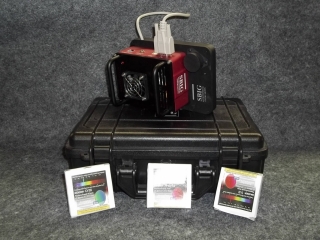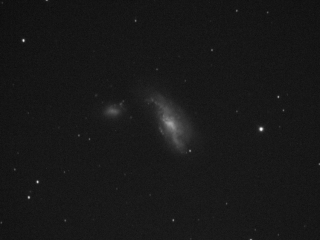I bought an SBIG ST-8300M
After months of design, prototyping and modifications in order to transform my Canon 350D DSLR into a better astronomical instrument, I finally gave in and purchased a thermoelectrically cooled CCD imaging cameras (i.e. the SBIG ST-8300M).
Here is the picture of the new toy…
My modified Canon still work quite well but I felt it was time for me to step into the world of more advanced astronomical CCD. I’ve been imaging with the 350D as my main camera since 2006. In 2008, I removed the Infrared filter in front of the sensor to make it more sensitive to red. In 2012, I added and thermo-electical cooling device to it in order to reduce the operating temperature and the associated dark signal it was suffering from. I was able to take very good pictures with it as you can see in the photo gallery of this site.
However, here is what motivated this purchase of the SBIG camera:
- Stumble on a great deal (bought it used) at a fraction of the price. The camera was never use.
- The camera is monochrome, therefore more sensitive than the color counterparts.
- It is a 16 bits camera and therefore provides a better dynamic range compared to the 12bits Canon DSLR.
- It has a mechanical shutter that will allow me to remotely create calibration frames (i.e. darks and bias).
- It came with an automated filter wheel and 3 narrowband filters that will allow me to capture images through the light polluted sky or even during the moon presence. I will be purchasing LRGB filters to make standard color images. This configuration will make the camera quite versatile.
- It is a cooled camera that can reach 35 degrees celsius below ambient temperature.
- It is an 8.3 million pixel camera that can be used in various binning mode (i.e. 1X1, 2X2 or 3X3). This is useful when trying to get the right image scale depending on the focal length of the telescope.
- The sensor characteristics are quite good (i.e. low dark current and read noise, adequate gain and quantum efficiency).
I did a preliminary test last night and I was quite impressed with the results. Here is a monochrome 5 minutes guided exposure of the NGC4490 galaxy. The image was not even calibrated (i.e. only stretching was applied). As you can see, with only 5 minutes the details are quite impressive and the dark noise (the camera was set at -35 degrees celsius)
Next items to buy to complete the setup:
- 20mm T-Thread spacer to properly position the Hotech field flattener at ~55mm of the sensor.
- Baader’s LRGB filter set to make color imaging.
- Extra filter carousel for the LRGB filters.
More to come about the new camera and it’s capabilities.
Thanks for reading.
Follow Clearskypix - 3D Printed Astronomy Parts and Accessories on Facebook.


